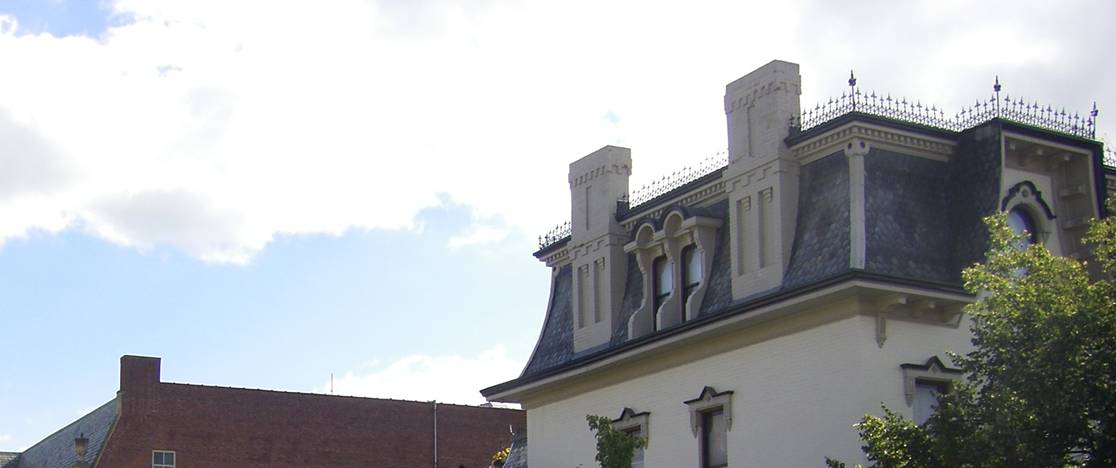When Dr. J. Hamilton Thurston decided to dabble in real estate development in the 1870s, he was taking a chance. Not only was he branching out from his successful dentistry practice, but he was trying to popularize a type of housing that was relatively unknown in western New York – row houses for the well-off.
His block of five upscale Victorian homes on East 4th Street, built between 1875 and 1880, were designed to provide Jamestown’s elite families with an alternative to the rambling mansions that were the norm and to mimic the row house neighborhoods being built by the wealthy of Boston, New York, Philadelphia, and other East Coast cities.
The homes sold to their intended users, but the concept got little traction in Jamestown, where growth pressures were relatively low and the supply of land too great to compel people – especially the rich – to live in such close proximity.
In the 1890s and early 1900s, Jamestown’s central business district spread northward and enveloped the Thurston block, making it less desirable for single-family residences. As families left, the block transitioned to a mixture of commercial uses and apartments. By the middle of the century, a combination of age, disinvestment, and suburbanization took their toll on these and other downtown properties, leading to a progression of low rent uses and structural decay.
The iconic block was saved from demolition in the 1970s when the city used federal dollars to stabilize the buildings and dress up the streetscape with planters and trees. Though many of the buildings remained underutilized, this work gave the block a new lease on life, as did investments by individual property owners. More than 30 years later, a painstaking façade renovation project funded by the Jamestown Renaissance Corporation gave the block a further boost.
Today, the block is in the midst of another transformation. This time, renewed interest in downtown and the city’s historic architecture – especially among younger generations – has made the block an epicenter of the city’s renaissance. In particular, the opening in 2013 of Brazil Craft Beer & Wine Bar directly above the Labyrinth Press Company, a coffee shop that will soon reopen after a summer of renovations, has created a concentration of amenities and activity that are vital to making downtown Jamestown a more attractive place to live, shop, work, and relax.
This evolution of the Thurston block reveals two key points about cities and revitalization.
The first is the importance of adaptation. Markets change. Cultures change. Technologies change. As a result, staying vital and livable for decades or centuries at a time is a function of being able to adjust to new conditions and opportunities at a variety of scales – city, neighborhood, and block. Being able to reinvent buildings and spaces to accommodate new uses is what drives the long-term health of cities. While the Thurston block has seen its ups and downs, it has adapted, survived, and is now a spark for downtown’s rebirth.
The second point, closely linked to the first, is the importance of flexibility. If the original use of the Thurston row houses – single-family residences – had been rigorously enforced to prevent the introduction of other uses, the buildings would likely have been obsolete and abandoned in the early 20th century rather than now exemplifying the layered mixture of uses that make cities functional, dynamic, and interesting.
Luckily, the mixture of uses that the Thurston block had accumulated into the early 1900s was maintained when zoning was introduced to Jamestown in the 1920s, around the time when most other American cities began adopting zoning as a form of land use regulation. But the effect of traditional zoning – to strictly regulate and separate uses – was not kind to cities or their ability to adapt. The comfort of predictability came at a price, and places such as the Thurston block became difficult, if not impossible, to replicate.
That’s why many cities are investigating or adopting form-based codes to replace traditional zoning. Such codes, including Buffalo’s proposed “Green Code,” focus more on the physical form of buildings – and how they relate to each other and surrounding spaces – than on trying to separate uses. You let the market determine use, parking supply, and other elements (within reason) while the form-based code regulates the overall feel of a place.
Replacing Jamestown’s outdated zoning code with one that makes the city, its land, and its buildings more adaptive is a needed step. If Jamestown and the Thurston block are to survive and thrive for the next hundred or 500 years, we have to take a chance – much like Dr. Thurston – and let innovation and reinvention happen.
–Peter Lombardi
This post appeared in The Post-Journal on September 29, 2014, as JRC’s biweekly Renaissance Reflections feature.

